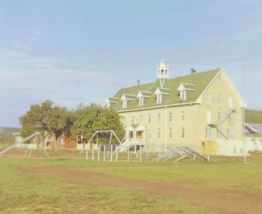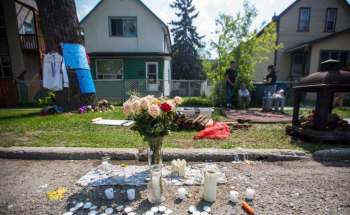Heart and soul of a neighbourhood Augustine United Church's renovation and conversion to community hub is a blueprint for crumbling houses of worship across Canada
Read this article for free:
or
Already have an account? Log in here »
To continue reading, please subscribe:
Monthly Digital Subscription
$0 for the first 4 weeks*
- Enjoy unlimited reading on winnipegfreepress.com
- Read the E-Edition, our digital replica newspaper
- Access News Break, our award-winning app
- Play interactive puzzles
*No charge for 4 weeks then price increases to the regular rate of $19.00 plus GST every four weeks. Offer available to new and qualified returning subscribers only. Cancel any time.
Monthly Digital Subscription
$4.75/week*
- Enjoy unlimited reading on winnipegfreepress.com
- Read the E-Edition, our digital replica newspaper
- Access News Break, our award-winning app
- Play interactive puzzles
*Billed as $19 plus GST every four weeks. Cancel any time.
To continue reading, please subscribe:
Add Free Press access to your Brandon Sun subscription for only an additional
$1 for the first 4 weeks*
*Your next subscription payment will increase by $1.00 and you will be charged $16.99 plus GST for four weeks. After four weeks, your payment will increase to $23.99 plus GST every four weeks.
Read unlimited articles for free today:
or
Already have an account? Log in here »
Hey there, time traveller!
This article was published 24/06/2021 (1629 days ago), so information in it may no longer be current.
Every morning on her way to work, Mel Prociuk clambers up the scaffold that hugs the spire jutting up from the east side of Augustine United Church. The metal and plywood steps clang as she rises above the trees, above the roofs of Osborne Village, and into the blue Prairie sky.
From the tip of the steeple, 46 metres above River Avenue the city splays out a blanket of leafy green, pierced by the blocky tops of nearby apartment towers. Across the river, the Golden Boy turns its back towards the church, which was already 15 years old when that statue first raised its torch atop the legislature dome.
For the two months they’ve been working to paint and restore the steeple, Prociuk and her Valour Decorating co-worker Lindsay Nakonechny have liked to sip their morning coffee up there, enchanted by the view, unfazed by the height. You can see the whole city from up there, Prociuk says, an incredible sight.
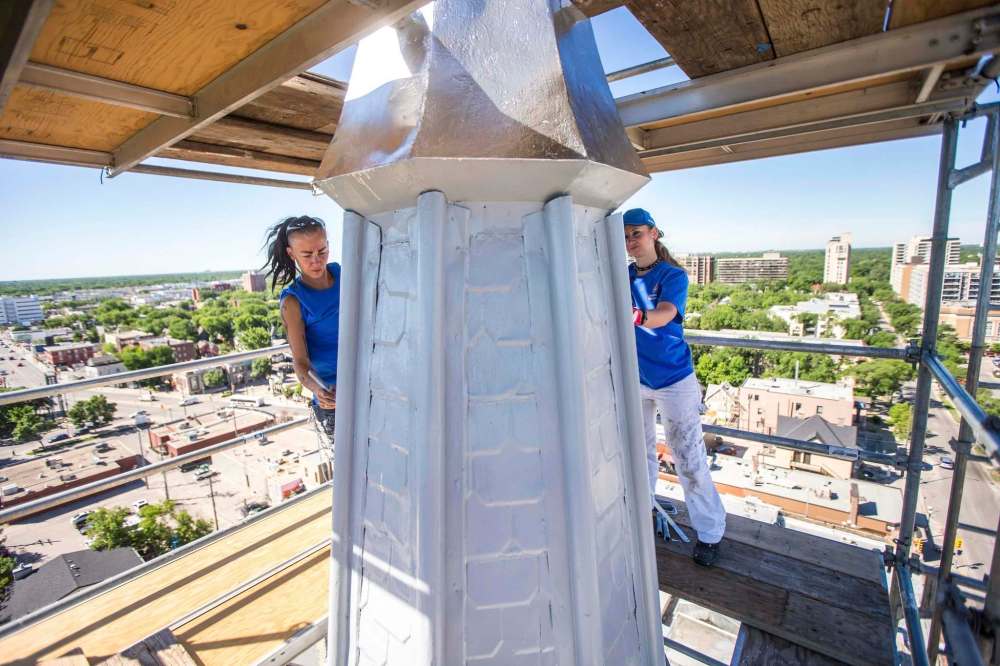
“It’s a once-in-a-lifetime opportunity… you’re never going to be that high again,” Prociuk says, squatting on a plywood platform about five storeys up the church’s elegant limestone face. “You can see all the green, all the beautiful buildings all around.”
When their work is done, the steeple will shine more brightly than it did in 1904, the year the church was completed. The cross at the top now wears a skin of gold leaf; lights underneath will beam a beacon. On July 1, the lights will flick on for the first time: a symbol of a building, and a church, in the process of renewing.
It won’t simply be Augustine United Church anymore. Now, it is Augustine Centre, a non-profit entity created to guide the building toward a vision as a community hub and union of like-minded tenants, with the sanctuary to serve as a performing arts and gathering space as well as a place for worship.
So far, improvements to the building have included a thoughtfully designed 4,500-square-foot space for the growing Oak Table non-profit, which supports hundreds of guests each week with everything from meals to health services and art classes. The former guild hall is also undergoing a massive renovation to create the 8,900-square-foot Splash Child Care Centre, which will open this summer with 24 infant and 44 preschool spaces.
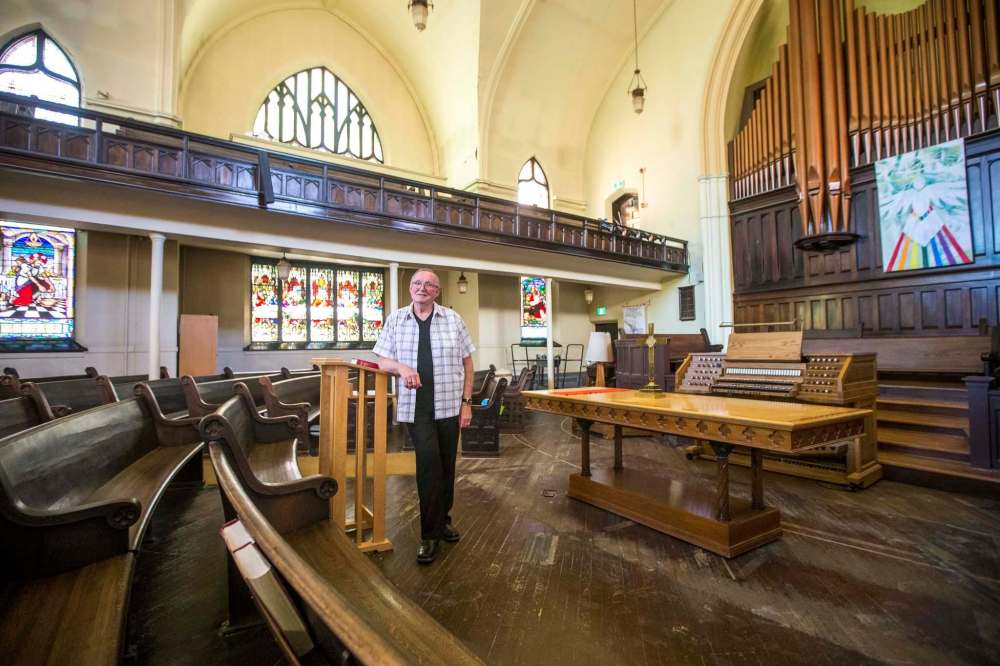
More changes are coming. To complete the $8.5-million transformation, much of which has been funded through grants, long-term financing and donations, this month Augustine Centre will launch a $1.5-million capital campaign. The hope is that others will join in to preserve one of the city’s most striking buildings — and, in a way, bring it back to what was.
“The catchphrase for this is ‘the heart of the Village,'” says Jeff Carter, a longtime church member and president of the Augustine Centre board. “A community hub is what we’re envisioning, and that’s exactly what this building was built for, but in a radically different time, with radically different undertones.”
In some ways, Augustine’s journey is not just the story of one church. It is the story, more broadly, of sweeping changes that have come to modern congregations, and to the monumental properties many inherited. It is also about how those churches find ways to forge ahead in keeping with their values and their mission.
To put that journey in context, it is best to start at the beginning.
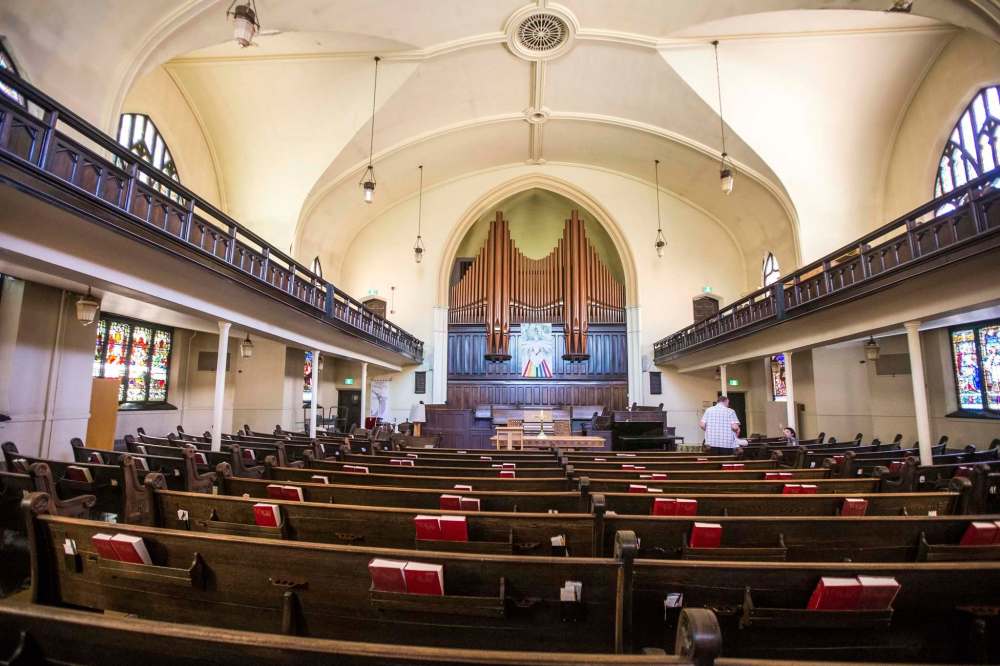
The early 20th century was a grand time for Winnipeg architecture. Augustine, designed by prominent architect J.H.G Russell, was one of a clutch of handsome churches that rose in quick succession, testament to the wealth that was accumulating in the growing city and to the central role the church played in community life.
From the beginning, the church, whose sanctuary and attached guild hall cost about $2 million to build in today’s dollars, made an imposing presence on the street. Its soaring steeple and elegant Gothic Revival face became a landmark of the neighbourhood, and the pride of a large and affluent congregation.
Church life was vibrant back then. When Christine Coltart moved to Winnipeg in 1946 after finishing university in Brandon, she rented a room from an Augustine congregant. In those days, Coltart recalls, the church was full on Sundays, with hundreds of people squeezing into pews throughout the main floor and balcony.
Before long, Coltart herself was deeply involved in the church. There were many young women her age, so she found friends in the congregation, and there was always something to do. She liked that the folks there seemed to live their faith, opening the church kitchens to feed people in need and looking for ways to help.

In 1981, the church began opening its doors all day, inviting anyone to come for a coffee and chat. That effort was eventually spun off as Oak Table community ministry, which today feeds hundreds of guests each week as part of its mission to “provide hospitality, support and advocacy for those in need of a safe, respectful community.” In 1995, Augustine made history when it became Canada’s first LGBTTQ+-affirming United congregation.
“The church was more than just a place to go on Sunday,” says Coltart, who is now 96. “It was involved in the community and looking to see what could be done… It’s always been a church that looked beyond the walls.”
But times were changing. Starting in the mid-1960s, congregations began to dwindle, and the church’s role in community life faded with it. When Coltart began going to Augustine, 67 per cent of Canadian adults attended church weekly; by 2013, as little as 13 per cent of Canadians attended any religious service weekly.
This declining Canadian religiosity fell particularly heavily on mainline Protestant denominations, including the United Church. Today, Augustine has 140 members, most of them seniors. Before COVID-19, about 50 to 90 people came to the average Sunday service.
”The legacy is wonderful. The beauty is wonderful. This is a beautiful church in many respects but the cost of upkeep can cripple you if you don’t have other resources. That’s where the congregation was getting to.” – Jeff Carter, president of the Augustine Centre board
While the congregation shrank, the costs of the building kept rising. It took Augustine members years to cobble together enough cash to pay for a needed roof replacement, which was completed in 2015; by then, water had seeped into the sanctuary’s ceiling, causing plaster to tumble. It will cost $675,000 to fix that damage.
By 2018, the building had become “an albatross around (the congregation’s) neck,” Carter says. Keeping up with basic bills cost more than $140,000 a year, to say nothing of more substantial required improvements; when the church lost a key tenant in 2017, the congregation’s finances were plunged into the red.
“The legacy is wonderful,” Carter says. “The beauty is wonderful. This is a beautiful church in many respects but the cost of upkeep can cripple you if you don’t have other resources. That’s where the congregation was getting to.
“Everyone loves historic properties, that’s the good news,” he adds, and gives a tired laugh. “In other words, it’s valued by the community, up to the point where you ask for money to help.”
It’s a squeeze many congregations feel, especially those who have inherited those monumental old buildings. The costs of stabilizing a sinking building or replacing an old heating system can soar high into the six figures, and even the seven: too heavy a burden for congregations that are now counted in the dozens.
Some churches have found ways to get through. In 1968, prescient members of Westminster United Church, at the corner of Maryland and Westminster, created the Westminster Foundation. At the time, the church’s finances were robust, but the members surmised there would be leaner years ahead.
That prescience proved critical. Opened in 1912, Westminster is another of architect J.H.G. Russell’s Winnipeg churches, arguably the grandest. In recent years it’s needed many repairs, including a major ceiling fix and rehabilitation of bowing stained glass windows.
Because of the foundation, which is managed separately from the church, the congregation was able to afford the repairs to keep the spectacular building healthy. Were it not for the foresight of those 1960s members, says Westminster board chair Carol Latter, the congregation today would be in far more difficult straits.
“This is where we’re saved by that foundation,” Latter says. “That’s the release valve that our congregation has from that worry that those funds are there for us. We still are very conscious of, the more you draw on them, the less likely they are to be there. So it’s a balancing act.”
”That’s the release valve that our congregation has from that worry that those funds are there for us. We still are very conscious of, the more you draw on them, the less likely they are to be there. So it’s a balancing act.” – Westminster board chair Carol Latter
Not all churches have been so lucky. Two years ago, the National Trust for Canada estimated that 9,000 worship spaces in Canada will shutter within the next decade. In Toronto, many historic churches have been redeveloped as condos, as have several old churches in Manitoba. Others across Canada have simply been razed.
Yet perhaps something is lost when buildings that had once been such a heartbeat of their neighbourhoods are relinquished to different, more private uses of the space. It is difficult, for instance, to imagine the visual texture of Osborne Village without its picturesque churches; their presence helps create a sense of place.
“We’re lucky in Winnipeg to have an inventory like this, still, that needs to be preserved and looked after,” says Karl Loepp, co-founder of real estate investment firm Private Pension Partners, who has been leading the work to restore Augustine’s steeple.
In a way, Loepp’s involvement reflects the bonds that historic churches still hold with their neighbourhoods. His company has its offices in Osborne Village; every day, Loepp drove past the aging church, seeing with dismay the disrepair of the steeple. One day, he approached church leaders to see if he could help.

“This steeple’s been a beacon of Winnipeg, long before the Golden Boy was up there,” Loepp says. “If you really travel anywhere in the world with great monumental cathedrals, they’re always the centrepiece of a townsite. It’s a gathering place, whether you’re there for faith or anything else. It’s a place that draws you in.
“It was sad that it was in such bad shape. It was such an important piece; why not bring it back to life?”
As Loepp learned more about the church’s plans to create Augustine Centre, he was inspired. When he began to reach out to donors, he was pleased by how many were quick to pitch in; before long, he’d helped raise over $300,000, enough to fully refurbish the steeple with some left over for the church’s next renovations.
The eagerness with which donors responded speaks to the affinity that exists for the buildings. It’s notable, for instance, that many Osborne Village residents profess to having a favourite among the community’s historic churches, even if they’ve never set foot in any; the beauty of the old designs has stood the test of time.

But to see these buildings through the decades to come will require more than just cash. For congregations, it often also means a great deal of reflection on what the church can be, what it means, and what it meant when the buildings were first raised. Because times have changed, and the context of the church is changing too.
Consider that the beauty of the old churches is also a monument to the wealth generated during the turn-of-the-century colonial scramble, a time when it was “church above everyone,” notes Rob Dalgleish, a United Church minister. It was a similar attitude that enabled residential schools and other church abuses.
And just a few decades before Augustine was built, the land on which it now sits belonged to a thriving Métis farming community, which was pushed out as affluent settlers, charmed by what was then the area’s bucolic ruralness, moved in. History can be beautiful, but on these lands, it is also complicated.
“The legacy of these huge dominating buildings… That’s also kind of a mixed blessing,” Dalgleish says, chatting over the phone from his office in Toronto. “‘Church over everyone’ is not a message the church would want to make right now. Communities themselves cherish the place of these buildings, so part of it is to maintain the good of that history, and the need to transform it.”
”The legacy of these huge dominating buildings… That’s also kind of a mixed blessing.” – United Church minister Rob Dalgleish
Ten years ago, Dalgleish co-founded the EDGE Network, linked to the United Church of Canada. It started as a way to help congregations innovate their ministry, in order to address the membership decline that has chipped away at the church; soon, it became clear that property was one of their foremost concerns.
In an EDGE survey of 600 churches, about a third reported property challenges so severe that they would have to redevelop or sell their building on a short-term horizon. Three years ago, EDGE added a property mission, to help congregations navigate how to adapt, preserve or repurpose their buildings, in tune with their values.
“We never anticipated getting into property issues,” Dalgleish says. “But almost every congregation we were working with was having significant issues with their property, struggling to keep up with maintenance of their facilities in their current conditions.
“These assets are the biggest physical asset of the church, but they’re not well-aligned with the kind of ministry we’re doing right now… Congregations are often quite desperate and feel like they’ve failed, because they can’t keep this thing going. It’s not that you can’t keep it going. It’s that you can’t keep it going in the form that it’s in.”
”We never anticipated getting into property issues. But almost every congregation we were working with was having significant issues with their property, struggling to keep up with maintenance of their facilities in their current conditions.” – United Church minister Rob Dalgleish
Which is to say, as congregations have become smaller, churches have sought to become more nimble. Now, church leaders are often looking to expand from the “box, book and preacher” model, towards a more flexible definition of what ministry looks like: it might be as simple as holding space for coffee and fellowship.
To narrow this gap between massive empty sanctuaries and modern life, EDGE encourages congregations to invite community members to meetings. These conversations have been “rich and generous,” Dalgleish says: through them, the problem of a building becomes an opportunity to give a community what it needs.
In all, EDGE has helped more than 600 congregations innovate their ministries. Not all involved changes to the church’s physical building, but all required reimagining how that property can be used. Some were inspired to share their space as a venue for local artists; others have launched new social enterprises.
“What are the values we want to proclaim? What kind of place do we want to make?” Dalgleish says. “It’s really a project of loving the neighbourhood. How can we love the neighbourhood with this real estate, in a way that’s sustainable, that honours the gift and historical journey of the church, but also reaches out in new ways?”
In Winnipeg, this approach has led to several significant church adaptations. In 2013, St. Matthew’s Anglican on Maryland Street began a $6.6-million transformation into the West End Commons, turning its vast sanctuary into 26 units of subsidized housing, complete with an indoor play area and separate space for worship.
Earlier this year, All Saints Anglican on Broadway completed its groundbreaking endeavour, a joint venture with the University of Winnipeg Community Renewal Corporation to replace its dilapidated parish hall with a soaring 110-unit mixed-income apartment complex, allowing income for the church but also affordable housing.
In this vein, the transformation of Augustine United Church into Augustine Centre will, the congregation hopes, carry the church into the future, but also, in a way, bring it back towards its roots. Once, it hummed with life as the centre of its community and heart of the Village; soon, perhaps, it will serve that role again.
”I just have to pinch myself. This little old church, this old congregation being able to even think of things like that.” – Christine Coltart
“I just have to pinch myself,” Coltart says. “This little old church, this old congregation being able to even think of things like that… some congregations might just fold up, dwindle away, but here we are trying new things. This is a new phase of its life, and I just hope it can be used for whatever. To provide friendship for a lot of people too.”
Change rarely comes easy. Yet when Augustine’s members voted for the plan that would make them tenants in the building and turn control over to the new Augustine Centre board, the vote was unanimous. There is a hope for the future, Carter says, and now, they hope Winnipeggers will show their support.
“People know we have no choice,” Carter says. “We have to move forward, and we’re courageous enough to do that.”
melissa.martin@freepress.mb.ca
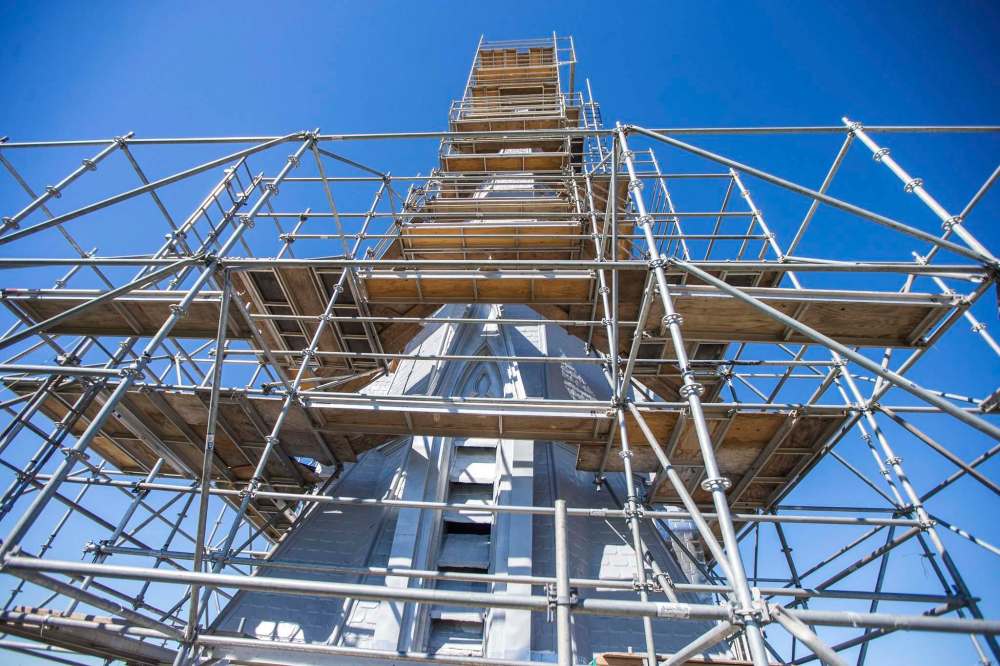
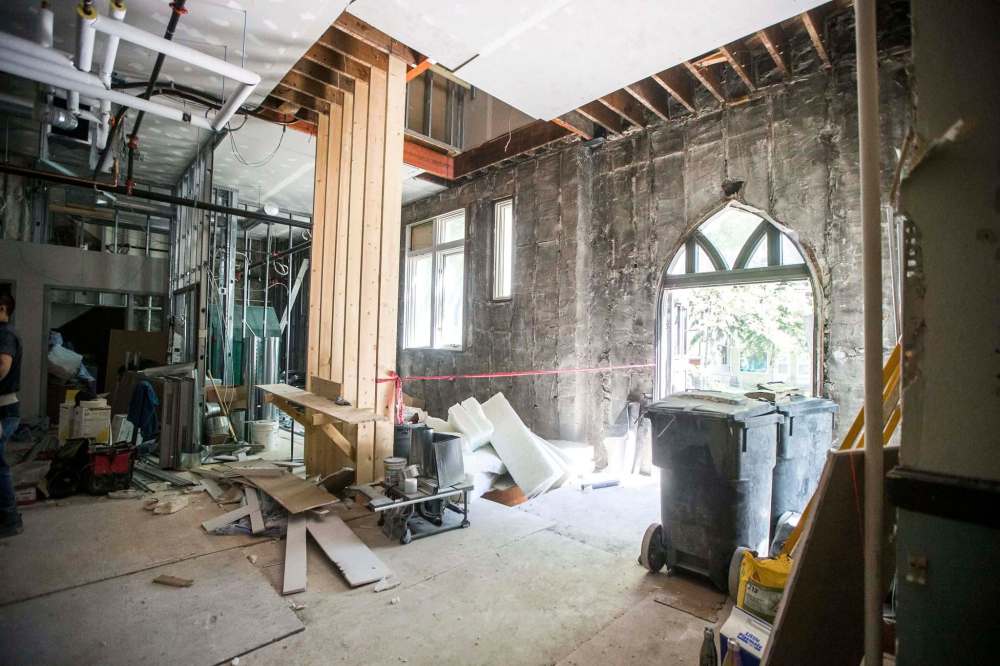
The Free Press is committed to covering faith in Manitoba. If you appreciate that coverage, help us do more! Your contribution of $10, $25 or more will allow us to deepen our reporting about faith in the province. Thanks! BECOME A FAITH JOURNALISM SUPPORTER
Our newsroom depends on a growing audience of readers to power our journalism. If you are not a paid reader, please consider becoming a subscriber.
Our newsroom depends on its audience of readers to power our journalism. Thank you for your support.
History
Updated on Thursday, June 24, 2021 9:38 PM CDT: Corrects spelling of innovate.
Updated on Thursday, June 24, 2021 9:49 PM CDT: Removes duplicate as as
The Free Press acknowledges the financial support it receives from members of the city’s faith community, which makes our coverage of religion possible.



